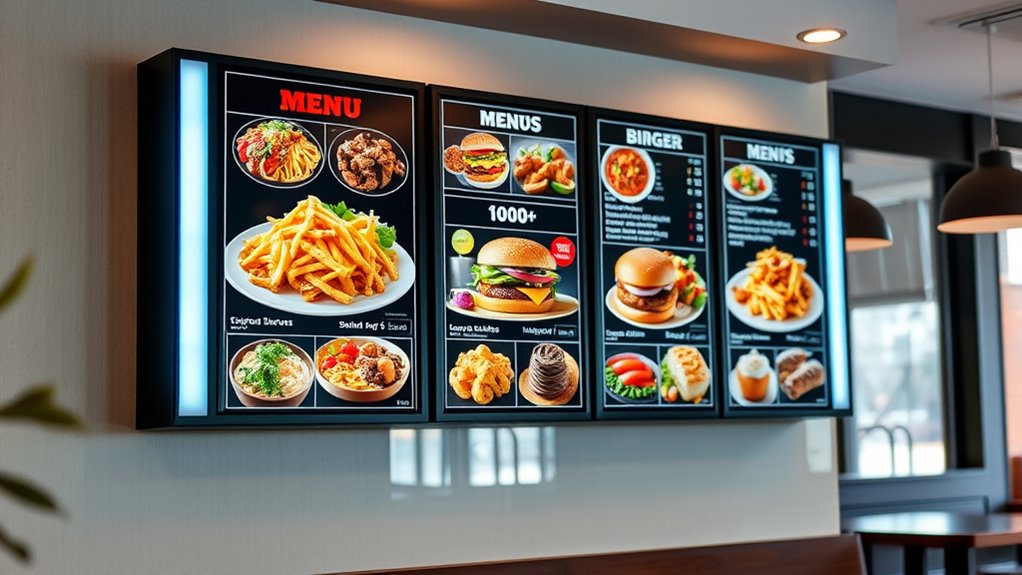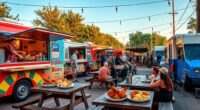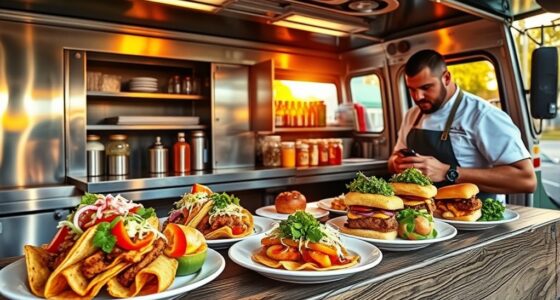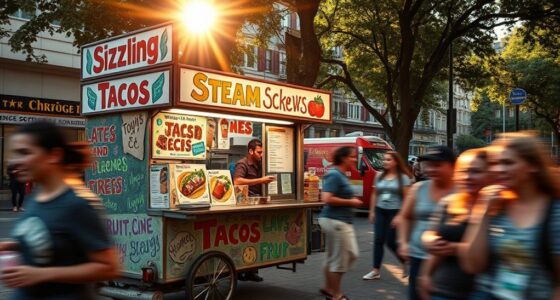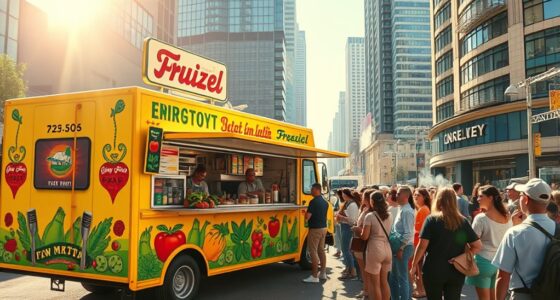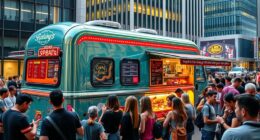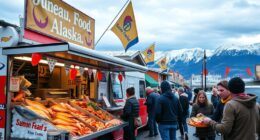To design a menu board that drives sales, focus on aligning it with your brand by using your colors, fonts, and logo for consistency. Organize content into clear categories and highlight best-sellers or high-margin items at eye level, making choices quick and easy. Use bold fonts and high-contrast colors for readability. Incorporate digital tools like AI for personalized offers and real-time updates. Keep exploring these strategies to boost your sales even further.
Key Takeaways
- Use brand colors, prominent logo, and consistent fonts to reinforce brand identity and build customer trust.
- Organize menu into clear categories and highlight best-sellers and high-margin items at eye level.
- Apply large, bold fonts with high-contrast colors for maximum readability and quick scanning.
- Leverage digital tools and AI for personalized offers, dynamic content updates, and real-time sales analysis.
- Showcase top-performing items, optimize placement for high-profit items, and regularly refine based on sales data.
Aligning Your Menu Board With Brand Identity

Have you ever wondered how your menu board can effectively reflect your brand identity? The key is consistency. Use your brand colors across the menu to reinforce recognition and foster an emotional connection. Make sure your typography matches your brand fonts to create a cohesive look that aligns with your overall marketing. Place your logo prominently to ensure immediate brand recognition and build trust. Reflect your brand’s personality through imagery—whether it’s rustic, modern, or playful—so customers instantly understand your style. Maintaining a uniform layout and design elements across all locations creates a seamless experience, strengthening customer loyalty. When your menu visually echoes your brand identity, it reinforces your message and leaves a lasting impression. Consistent design elements help customers recognize your brand quickly and enhance overall brand perception, especially when considering brand recognition in competitive markets.
Organizing Content for Maximum Impact
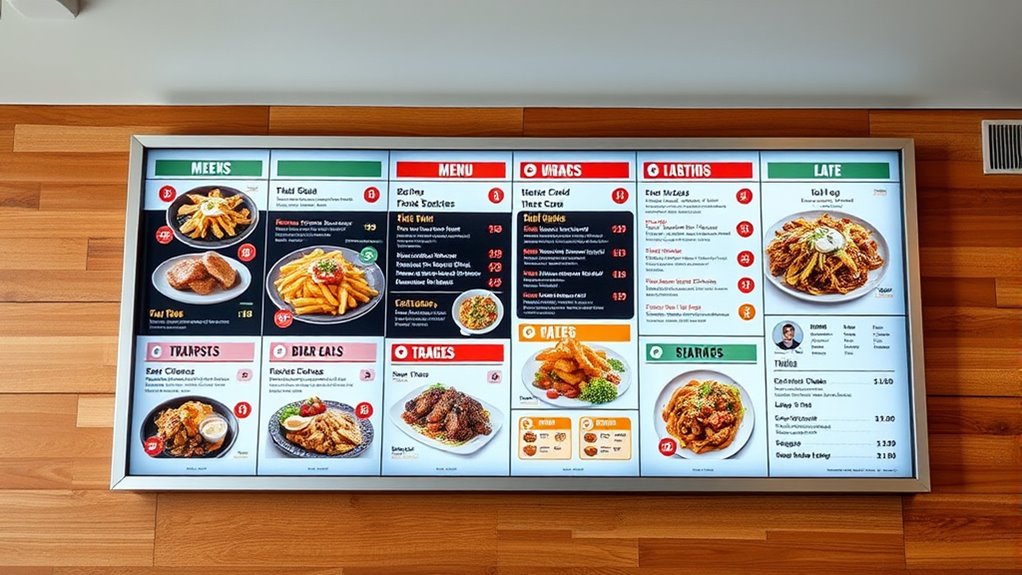
Organizing your menu content effectively can considerably enhance customer experience and boost sales. Start by dividing your menu into clear categories like appetizers, mains, and drinks to make navigation simple and reduce decision fatigue. Limit the number of visible items per screen to prevent overwhelming customers and speed up choices. Group related items logically, and highlight best sellers or high-margin items within each section to catch attention. Use spatial separation and white space to distinguish sections, making the menu easy to scan. Position high-profit and popular items at eye level or in prominent spots for maximum exposure. Employ visual cues like borders or icons to emphasize specials or attributes. A well-structured layout guides customers effortlessly toward the most profitable options, increasing sales potential. Incorporating visual hierarchy principles can further improve readability and focus within your menu design. Consistent branding and layout organization can further reinforce your restaurant’s identity and make the menu more intuitive for customers.
Enhancing Readability and Visual Appeal

How can you make your menu more visually appealing and easy to read? Start by choosing large, bold fonts with thick strokes, ensuring readability from 15 feet or more. Keep text within the “golden triangle” zone where customers’ eyes naturally focus. Use high-contrast color combinations, like white or light text on dark backgrounds, to maximize visibility, and avoid busy patterns behind text. Incorporate warm colors, such as red and orange, to stimulate appetite, while cool tones like blue and green suggest freshness. Maintain consistent spacing—15-20 pixels between items and 30-40 pixels between categories—to improve flow. Use ample white space around prices and descriptions to reduce clutter. Regularly test readability under different lighting conditions and gather customer feedback to refine your design for clarity and visual appeal. Additionally, leveraging AI-driven analytics can help identify which design elements most effectively capture customer attention and improve overall readability. Incorporating essential oils into your environment can also subtly influence customer mood and enhance their dining experience.
Leveraging Digital and AI Technologies

Leveraging digital and AI technologies transforms how you manage and display your menu, creating more personalized and efficient customer experiences. With AI-driven personalization, you can offer targeted discounts and loyalty offers that encourage customers to spend more. AI analyzes real-time ordering patterns to suggest relevant add-ons, boosting average order value. You can dynamically adjust menu content based on factors like time of day, weather, or customer demographics, maximizing sales opportunities. Centralized cloud management allows instant updates across multiple locations, reducing costs and labor. Automated inventory-aware menus prevent out-of-stock issues, while AI-driven scheduling aligns promotions with peak traffic. Additionally, real-time analytics enable you to make data-driven decisions, optimizing service flow and increasing upselling success, ultimately driving higher sales and improved ROI. Studies show that digital menu boards lead to an average sales increase of 8-10%, demonstrating their effectiveness in boosting revenue. Incorporating sound healing science concepts, such as analyzing sound vibrations and frequencies, can also enhance the overall customer experience and ambiance in your establishment.
Utilizing Data to Optimize Sales and Promotions

Using data effectively allows you to identify your most profitable and popular menu items, enabling targeted promotion and strategic placement. About 16% of your menu drives 80% of sales, so highlighting these top performers boosts revenue. Analyzing sales and ingredient costs helps you set smarter prices that balance demand and profitability. Promoting high-margin items in high-visibility spots increases their sales potential. Removing underperformers reduces waste and simplifies operations, cutting costs. Continuously tracking sales volume and costs provides insight to refine your menu. Incorporating menu engineering principles can further optimize your offerings and maximize revenue.
Frequently Asked Questions
How Can I Incorporate Seasonal Themes Into My Menu Board Design?
To incorporate seasonal themes into your menu board, you should update content regularly with vibrant visuals and themed colors like warm autumn tones or fresh spring greens. Highlight seasonal specials at the top or in dedicated sections, using eye-catching graphics or motion effects. Keep the layout clean and readable, emphasizing limited-time offers with clear messaging. Adding interactive elements like QR codes can deepen customer engagement and make your seasonal promotions stand out effectively.
What Are the Best Practices for Updating Digital Menu Content Quickly?
You need to update your digital menu content faster than lightning strikes to stay ahead. Use cloud-based platforms for instant, remote updates across multiple locations, so your menus are always fresh and relevant. Automate routine changes, leverage AI for personalized suggestions, and conduct A/B tests to find what works best. Prioritize clear, engaging visuals and schedule updates systematically. With these practices, you’ll keep customers captivated and boost sales effortlessly.
How Do I Balance Aesthetics With Functionality in a Busy Setting?
You need to balance aesthetics with functionality by choosing a minimalist design that aligns with your brand, ensuring clear fonts and high contrast for readability. Place your menu at eye level with good lighting, avoiding clutter. Use color coding or icons to guide focus, and consider digital options for quick updates. Keep it simple and organized so customers can easily find what they want, even during busy hours.
What Color Schemes Are Most Effective for Different Restaurant Concepts?
You should choose color schemes that match your restaurant concept. For fast-food places, use warm reds and yellows to energize customers and boost orders. For fine dining, cool blues and greens create a relaxed, trustworthy vibe. Organic restaurants benefit from earth tones like browns and greens, emphasizing natural ingredients. Luxury spots often incorporate neutral tones with metallic accents for sophistication. Pick colors that align with your atmosphere to attract and engage the right customers.
How Can I Use Customer Feedback to Improve Menu Board Effectiveness?
You can’t afford to ignore customer feedback—it’s the goldmine that unlocks menu board success! Use surveys, social media comments, and reviews to discover what truly matters to your customers. Highlight popular items, clarify confusing prices, and tailor content to their preferences. Track how these changes boost sales, engagement, and satisfaction. Continuous feedback loops keep your menu fresh, relevant, and irresistibly effective, turning casual viewers into loyal, repeat customers.
Conclusion
By aligning your menu board with your brand, organizing content strategically, and making it visually appealing, you turn it into a sales magnet. Embrace digital and AI tools like a painter wields a brush, adding vibrant strokes of innovation. Let data be your compass, guiding you through the maze of customer preferences. When these elements come together, your menu board becomes a lively canvas that beckons customers, turning their curiosity into a symphony of sales.
